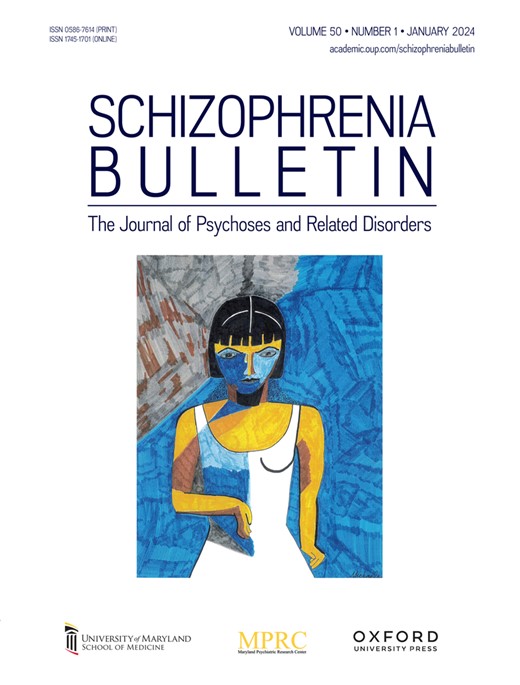负性分裂型与共情准确性动态功能连通性弱相关
IF 5.3
1区 医学
Q1 PSYCHIATRY
引用次数: 0
摘要
背景与假设先前关于共情准确性任务(empathy Accuracy Task, EAT)的研究表明,精神分裂症患者在楔前叶、额叶中回和丘脑中表现出大脑激活的改变。然而,尚不清楚患有精神分裂型的个体是否会表现出与EAT相关的类似的大脑激活改变。本研究旨在探讨进食过程中分裂型与主体间相关(ISC)之间的关系。研究设计47名大学生在3T核磁共振扫描仪上进行了中文版的EAT。查普曼社会快感缺失量表(CSAS)和知觉偏差量表(PAS)分别用于记录阴性和阳性分裂型。我们采用GLM分析、ISC分析和动态功能连通性分析来研究EAT与维度分裂型和自我报告共情的关系。研究结果无论分裂型评分如何,枕中皮层、楔前叶、舌回、中央旁回和前扣带皮层(ACC)的大脑激活与参与者的共情准确性相关,而双侧颞上回(STG)的大脑激活存在强烈的ISC。负性分裂型与中央前回激活的ISC以及STG和ACC之间的动态连接相关,这两者进一步介导了负性分裂型与自我报告情感共情之间的关联。结论中枢前回脑激活的主体间同步性减弱以及STG和ACC之间的动态连通性与阴性分裂型有关。我们的发现可能会揭示精神分裂症谱系障碍患者社会认知受损的潜在神经机制。本文章由计算机程序翻译,如有差异,请以英文原文为准。
Negative Schizotypy Associated With Weaker Intersubject Correlation in Dynamic Functional Connectivity During Empathic Accuracy Task
Background and Hypothesis Previous studies on Empathic Accuracy Task (EAT) suggested patients with schizophrenia exhibited altered brain activations in the precuneus, middle frontal gyrus, and thalamus. However, it remains unclear whether individuals with schizotypy would exhibit similar alterations of brain activations associated with EAT. This study aimed to examine the relationships between schizotypy and intersubject correlation (ISC) during EAT. Study Design Forty-seven college students undertook the Chinese version of EAT in a 3T MRI scanner. The Chapman Social Anhedonia Scale (CSAS) and Perceptual Aberration Scale (PAS) were used to capture negative and positive schizotypy, respectively. We adopted GLM analysis, ISC analyses of brain activation, and dynamic functional connectivity during EAT to examine its association with dimensional schizotypy and self-report empathy. Study Results Regardless of schizotypy scores, brain activations in the middle occipital cortex, precuneus, lingual gyrus, paracentral gyrus, and anterior cingulate cortex (ACC) were associated with participants’ empathic accuracy, while strong ISC of brain activations were found in bilateral superior temporal gyri (STG). Negative schizotypy was associated with ISC of brain activation in the precentral gyrus and dynamic connectivity between the STG and ACC, both of which further mediated the associations between negative schizotypy and self-report affective empathy. Conclusions These preliminary findings suggest that weaker intersubject synchronization of brain activation in the precentral gyrus and dynamic connectivity between the STG and ACC is related to negative schizotypy. Our findings may shed light on the underlying neural mechanisms of impaired social cognition in patients with schizophrenia spectrum disorder.
求助全文
通过发布文献求助,成功后即可免费获取论文全文。
去求助
来源期刊

Schizophrenia Bulletin
医学-精神病学
CiteScore
11.40
自引率
6.10%
发文量
163
审稿时长
4-8 weeks
期刊介绍:
Schizophrenia Bulletin seeks to review recent developments and empirically based hypotheses regarding the etiology and treatment of schizophrenia. We view the field as broad and deep, and will publish new knowledge ranging from the molecular basis to social and cultural factors. We will give new emphasis to translational reports which simultaneously highlight basic neurobiological mechanisms and clinical manifestations. Some of the Bulletin content is invited as special features or manuscripts organized as a theme by special guest editors. Most pages of the Bulletin are devoted to unsolicited manuscripts of high quality that report original data or where we can provide a special venue for a major study or workshop report. Supplement issues are sometimes provided for manuscripts reporting from a recent conference.
 求助内容:
求助内容: 应助结果提醒方式:
应助结果提醒方式:


